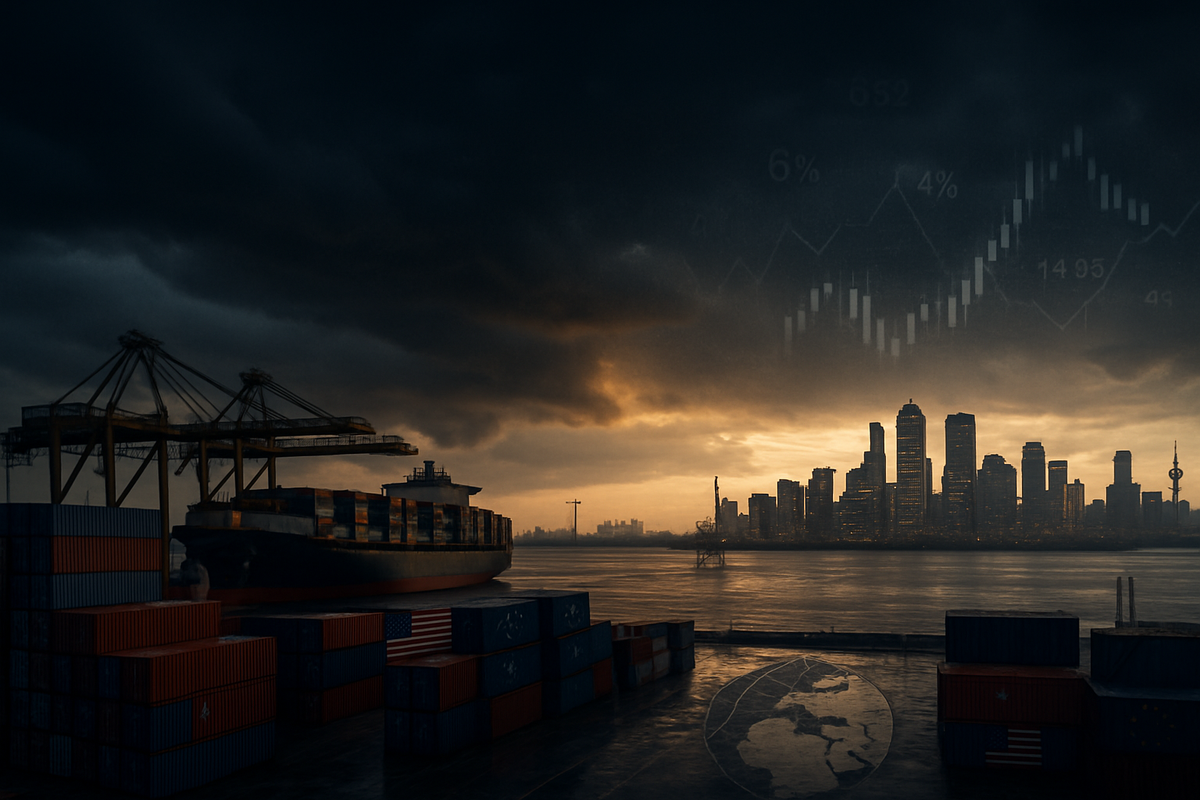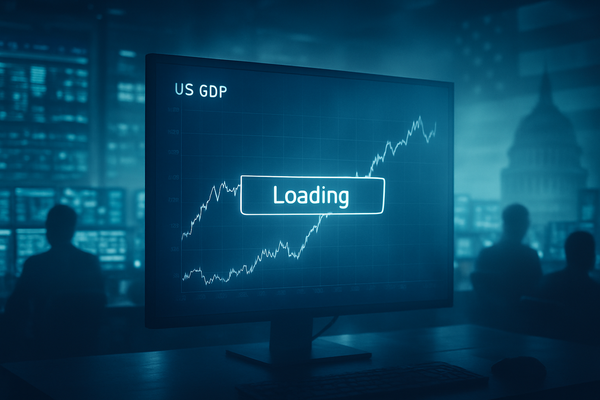Global Storm Gathers: Trade Wars and Geopolitical Firestorms Fuel Inflation and Market Turmoil

The global economic landscape is currently navigating a tempest of escalating trade restrictions and persistent geopolitical conflicts, creating an unprecedented climate of inflationary pressure and financial market volatility. From the resurgence of protectionist policies spearheaded by the United States to the enduring conflicts in Eastern Europe and the Middle East, these interconnected forces are fundamentally reshaping global supply chains, energy markets, and investor sentiment. This turbulent environment signals a new era of economic uncertainty, affecting everything from the cost of everyday goods to the strategic decisions of multinational corporations and the confidence of consumers worldwide.
As nations grapple with securing critical resources and asserting economic sovereignty, the ripple effects are manifesting in higher prices, disrupted trade routes, and a palpable sense of unease across financial markets. The cumulative impact of these developments threatens to unwind decades of globalization, compelling central banks to navigate a delicate balance between curbing inflation and avoiding economic stagnation, while businesses and investors are forced to adapt to a rapidly shifting paradigm.
A World Divided: Protectionism Rises Amidst Persistent Global Instability
The year 2025 has been marked by a significant escalation in global trade restrictions, most notably driven by expanded US tariffs. On April 2, 2025, the US introduced its "Liberation Day" tariffs, impacting nearly all sectors of the US economy. These tariffs extended beyond specific regions, with rates announced for various nations: Canadian goods faced a 35% tariff, South African goods 30%, and Vietnamese goods 20%, all effective by August 7, 2025. Additionally, India saw a two-stage imposition of a total 50% tariff on its exports to the US by early August. Broader import tariffs of 10% or more were also applied worldwide, calculated as "reciprocal tariffs" to balance bilateral trade deficits. Consequently, the average effective US tariff rate surged to 15.8% by August 2025, a dramatic increase from 2.3% at the end of 2024, with projections indicating a potential rise to 18-20%. These aggressive trade barriers are not merely political statements; they are tangible disruptions to global supply chains, increasing operational costs, and causing significant delays in the movement of goods.
Concurrently, the global stage remains plagued by a series of entrenched geopolitical conflicts. The Russia-Ukraine War continues to destabilize European energy security and global supply chains, while the escalating Israel-Hamas War and broader Middle East instability pose a critical threat to global energy markets and crucial trade arteries. Disruptions to Red Sea shipping lanes, particularly through the Suez Canal and the Strait of Hormuz, have led to soaring shipping costs and heightened fears of broader supply disruptions. Furthermore, persistent US-China tensions, characterized by "de-risking" efforts, China's increased military presence in the South China Sea, and ongoing technological and trade disputes, contribute significantly to global geopolitical uncertainty. Other regional instabilities, such as those in Libya and the growing threat of sophisticated cyberattacks, further underscore a volatile global environment.
These dual pressures are directly fueling a resurgence of inflationary pressures worldwide. Trade restrictions, particularly tariffs, act as an effective tax on consumers and businesses, driving up import prices. The 2025 tariffs alone are estimated to increase the overall US price level by 1.8% in the short run, equating to an average household income loss of $2,400. Sectors like clothing and textiles are experiencing disproportionately high price increases, with shoe prices rising by 39% and apparel by 37% in the short term. While some companies may absorb a portion of these costs, this strategy is unsustainable, leading to reduced production efficiency and sustained increases in marginal costs, especially for intermediate goods. Geopolitical conflicts compound this by causing spikes in energy and food prices. For example, a US bombardment of Iranian nuclear sites in June 2025 sent oil prices surging by over 13%, reaching levels not seen since early 2025. Threats to critical chokepoints like the Strait of Hormuz can add a "$5-15 per barrel" risk premium to global oil prices. Higher oil and gas prices translate rapidly into increased costs across transportation, manufacturing, and consumer goods, while Red Sea attacks have more than doubled shipping costs since late 2024, exacerbating the inflationary spiral.
The profound uncertainty stemming from these events is a primary driver of increased financial market volatility. Investor confidence is noticeably eroding, leading to a shift of capital towards traditional safe-haven assets. The Cboe Volatility Index (VIX) has seen significant surges, reflecting a market on edge. Global stock markets experienced a crash starting April 2, 2025, following the announcement of new US tariff policies, marking the largest global market decline since 2020. Major geopolitical risk events typically correlate with average monthly stock market declines of about 1 percentage point across countries, and a larger 2.5 percentage points in emerging markets. Oil markets are particularly sensitive, with trading volumes in futures contracts surging during significant events. Bond markets are also affected, with geopolitical risks leading to higher sovereign risk premiums, increasing government borrowing costs, particularly for emerging economies. This pervasive instability, coupled with evolving policy uncertainty, particularly regarding the outcomes of political events like the 2024 US Presidential Election, ensures ongoing market sensitivity and heightened volatility.
Navigating the Storm: Domestic Industries and Defense Thrive as Globalized Businesses Stumble
In this era of heightened protectionism and supply chain fragility, certain domestic industries are emerging as unlikely beneficiaries. Tariffs, by making imported goods more expensive, create a competitive advantage for local manufacturers. The push for "reshoring" and "nearshoring" – driven by geopolitical tensions and the desire for supply chain resilience – is further bolstering these sectors. Companies like Bosch, for instance, are increasing investments in their U.S. operations to localize production and mitigate rising material costs. Similarly, SGL Lighting has expanded its U.S. presence to eliminate supply chain challenges and reduce lead times, while United Safety Technology Inc. (UST) is building new facilities in the U.S. to produce essential medical goods, securing critical healthcare supply chains. The technology sector also sees winners, particularly those supported by governmental acts like the U.S. CHIPS Act. Major players such as Intel (NASDAQ: INTC), Texas Instruments (NASDAQ: TXN), and Taiwan Semiconductor (NYSE: TSM) are receiving grants to expand domestic semiconductor production, while Ford (NYSE: F) is investing in new U.S. plants for electric vehicle (EV) manufacturing.
Geopolitical conflicts invariably translate into increased demand for defense capabilities. Aerospace and defense contractors are experiencing a surge in orders as governments worldwide prioritize military readiness and modernize their arsenals. Giants like Lockheed Martin (NYSE: LMT) and Raytheon (NYSE: RTX) are securing multi-billion dollar contracts for advanced weapons systems and support. Specialized defense companies focusing on drone warfare, cybersecurity, and advanced sensor systems are also finding new opportunities. Furthermore, the imperative for energy independence, spurred by volatility in global energy markets due to conflicts, is driving investments in domestic energy production and renewable sources. While specific "winner" companies in traditional energy were not named in the research, producers in politically stable regions generally benefit from higher oil and gas prices, and the broader shift towards renewable energy for national security purposes is accelerating.
Conversely, a significant portion of globally integrated manufacturing and the retail sector faces considerable headwinds. Manufacturers heavily reliant on imported raw materials or components, or those with extensive global supply chains, are experiencing increased production costs due to tariffs on inputs and escalating freight and insurance expenses from disrupted shipping routes. Automakers like Ford (NYSE: F) and General Motors (NYSE: GM) have already incurred hundreds of millions in additional costs from tariffs on steel and aluminum, impacting earnings forecasts. Similarly, Whirlpool (NYSE: WHR) has seen its quarterly earnings affected by rising steel prices. Export-oriented manufacturers are also suffering from retaliatory tariffs, reducing their market access. The retail sector, particularly those sourcing products globally and operating on thin margins, is being hit by higher procurement costs, which are often passed to consumers, dampening demand. Economic uncertainty and inflation further erode consumer purchasing power, leading to reduced spending on discretionary goods.
Businesses that are heavy energy consumers, such as manufacturing and transportation, are losing out due to the volatility and spikes in crude oil and natural gas prices caused by geopolitical events. This directly translates to higher operational costs. The logistics sector, including shipping companies and freight forwarders, is grappling with disrupted routes, longer transit times, increased fuel costs, and higher war-risk insurance premiums, all of which drive up operational expenses and create delays. The technology sector, with its intricate globalized supply chains for critical components like semiconductors, is also vulnerable. Trade wars and geopolitical competition lead to tariffs on these components, increasing production costs and potentially stifling innovation. Export restrictions and sanctions can limit access to essential technologies or markets, forcing costly "rip and replace" initiatives, such as U.S. telecom companies removing equipment from Chinese firms like Huawei and ZTE. Ultimately, the pervasive economic uncertainty affects nearly all sectors, dampening consumer and business confidence and delaying investment plans.
The Unraveling of Globalization: Economic Fragmentation and Strategic Recalibration
The combined onslaught of trade restrictions and geopolitical conflicts is fundamentally reshaping global economies, marking a significant departure from the principles of unrestricted globalization that have defined the past few decades. The immediate fallout includes reduced economic growth and pervasive inflationary pressures, as tariffs elevate import costs and disrupt intricate supply chains. Economists largely concur that persistent trade wars inevitably stifle economic expansion and diminish national competitiveness. The International Monetary Fund (IMF) has warned that technological fragmentation alone could slash global GDP by approximately 5%. Supply chains, once optimized purely for cost efficiency, are now being recalibrated for resilience. Events ranging from the COVID-19 pandemic to military conflicts and rising nationalism have exposed their fragility, leading to increased transit times, soaring freight costs, and customs delays that collectively inflate production costs and reduce operational efficiency across industries.
This volatile environment is profoundly influencing investment decisions and compelling a radical shift in corporate strategies. Increased geopolitical risk is fostering a pervasive risk aversion among investors, diverting foreign direct investment (FDI) away from unstable regions towards more secure economies. Financial markets, therefore, remain highly sensitive to evolving trade tensions and geopolitical uncertainties, with market stress potentially curtailing new credit flows and restraining overall investment. Businesses, in turn, are re-evaluating their global footprints. "Reshoring," "nearshoring," and "friend-shoring" initiatives are gaining traction as companies diversify sourcing and manufacturing away from single-country dependencies. The "China+1" strategy, where companies like Apple (NASDAQ: AAPL) have been diversifying significant portions of their production to countries like Vietnam and India, exemplifies this pivot towards resilience over pure cost optimization, even if it entails higher operational costs. Corporate boards are increasingly integrating geopolitical risk management into their core strategic frameworks, recognizing it as a critical component of long-term viability.
The regulatory and policy landscape is also undergoing a dramatic transformation. Trade disputes, often triggered by protectionist measures, are increasingly finding their way to the World Trade Organization (WTO), but the organization's dispute settlement mechanism has been significantly weakened, particularly by the paralysis of its Appellate Body. This erosion of multilateral institutions signals a broader retreat from the liberal international economic order, leaving smaller economies more vulnerable and encouraging a proliferation of bilateral and regional trade agreements as nations seek alternative frameworks. Governments are actively pursuing new industrial policies, using incentives like the U.S. CHIPS and Science Act to bolster domestic production of critical goods, such as semiconductors. Furthermore, geopolitical tensions are driving technological decoupling, as seen in the US-China rivalry, forcing companies to navigate competing legal frameworks and data localization laws, which can lead to market fragmentation and potentially a "splinternet," where global innovation is slowed by duplicated efforts and reduced interoperability.
History offers potent warnings and parallels to the current global situation. The notorious Smoot-Hawley Tariff Act of 1930, which drastically raised tariffs and is widely blamed for exacerbating the Great Depression by triggering retaliatory trade wars, serves as a grim reminder of the self-defeating nature of protectionism in an interconnected world. The US-Japan trade tensions of the 1980s, which saw the U.S. impose restraints on Japanese automobiles and electronics, ultimately spurred Japan to increase manufacturing within the U.S. and diversify its production, demonstrating how trade conflicts can paradoxically drive strategic shifts. Today's environment is frequently compared to a "Cold War 2.0" scenario, characterized by intensifying strategic competition between major powers. This forces companies to navigate a world where they may be pressured to align with specific geopolitical blocs, leading to operational complexities, increased costs, and a broader "geopolitical insurance premium" being embedded into everything from energy prices to supply chain logistics. The "peace dividend" that followed the original Cold War, which spurred decades of globalization, is now giving way to an era of fragmentation and heightened global risk.
Navigating the New Normal: Resilience, Regionalization, and Strategic Adaptation
In the immediate future, spanning late 2024 through 2025, global markets are poised for continued turbulence. The persistent geopolitical volatility, particularly from the ongoing Russia-Ukraine war and the Israel-Hamas conflict, will likely sustain high levels of instability in energy and commodity markets. Europe, now more reliant on Middle Eastern natural gas, faces considerable threats from supply interruptions. The resurgence of protectionist trade policies, especially the "America First Trade Policy" from the US, is expected to continue triggering escalating tariffs and retaliatory measures. These will likely lead to sustained increases in import costs, exacerbating inflationary pressures and further slowing global economic growth. Experts are forecasting a significant global economic slowdown for 2025, with increasing concerns about stagflationary pressures—slower growth coupled with rising inflation. Investor confidence will remain fragile, driving a continued rotation of capital towards traditional safe-haven assets. Businesses, in the short term, will grapple with elevated operational expenses from increased insurance and logistics premiums, alongside squeezed profit margins due to tariffs and reduced consumer purchasing power.
Looking further ahead, the convergence of these challenges is driving fundamental, long-term structural shifts, ushering in what many describe as a "new global economic order." The acceleration of "friend-shoring" and "nearshoring" is anticipated, with companies strategically reorienting global trade towards more politically aligned partners or closer geographic regions. This long-term pivot prioritizes supply chain resilience and geopolitical stability over pure cost efficiency. Economic decoupling, particularly between the United States and China, is expected to intensify, influencing technology flows, investment patterns, and the formation of new trade blocs and regionalized economies. Businesses must adopt a "geopolitics-first" approach, embedding robust scenario planning and real-time monitoring of geopolitical events into their core strategies. This includes aggressive diversification of suppliers, investment in localized production, and building flexibility into operations, with supply chain analytics becoming a critical tool to assess risks and optimize strategies.
While the challenges of increased costs, trade fragmentation, and economic slowdown are undeniable, this environment also presents new opportunities. For investors, a rotation into defensive assets like energy and gold can serve as a hedge against geopolitical escalation and inflation, with stable sectors such as utilities and healthcare potentially offering resilience. The immense need for resilient supply chains creates fertile ground for companies offering advanced technological solutions, including AI-driven predictive analytics and blockchain. Emerging markets, especially those leveraging regional trade agreements like the RCEP in Asia or the AfCFTA in Africa, are positioning themselves as crucial alternative trade partners and hubs for logistics and production. Companies involved in industrial automation and construction could benefit from the drive to reshore manufacturing. The defense and security sectors will continue to see increased spending. Ultimately, this volatile period is not merely a disruption but a powerful catalyst for innovation, compelling businesses to rethink supply chains, explore new markets, and develop more robust and adaptable business models.
The Dawn of a Fractured Global Economy: A Call for Agility and Strategic Foresight
The current confluence of escalating global trade restrictions and entrenched geopolitical conflicts has plunged the world into an era of profound economic uncertainty. From the immediate inflationary pressures stemming from new US tariffs and disrupted supply chains, to the heightened market volatility fueled by conflicts in Eastern Europe and the Middle East, these interconnected factors are fundamentally altering the global economic fabric. We are witnessing a clear shift away from unbridled globalization towards a more fragmented, regionalized, and protectionist landscape. Businesses are facing unprecedented challenges in managing costs, maintaining supply chain integrity, and navigating complex regulatory environments, while investors grapple with eroding confidence and the imperative to recalibrate their risk assessments.
Moving forward, the global market is likely to remain highly sensitive and unpredictable. The "new normal" will be characterized by persistent inflation, driven by structural supply-side pressures and geopolitical risk premiums, and continued market volatility. Central banks will face an arduous task in balancing inflation control with the avoidance of recession, potentially leading to prolonged policy uncertainty. The emphasis on national security and economic sovereignty will continue to drive industrial policies, encourage domestic production, and accelerate technological decoupling between major powers. This environment demands that companies move beyond traditional risk management, integrating geopolitical foresight directly into their strategic planning and operational execution.
The lasting impact of these events will be a more complex, less efficient, but potentially more resilient global economy. While the immediate outlook presents significant headwinds, it also catalyzes innovation and strategic adaptation. For investors, the coming months will require vigilant monitoring of several key indicators: the trajectory of global inflation data, the escalation or de-escalation of geopolitical conflicts, the policy responses of major central banks, and the ongoing evolution of trade policies. Companies that can swiftly adapt their supply chains, diversify their market access, and embrace a "geopolitics-first" mindset are best positioned to not just survive, but potentially thrive, in this fractured global economy. The era of predictable global markets has given way to one demanding unparalleled agility and strategic foresight.



